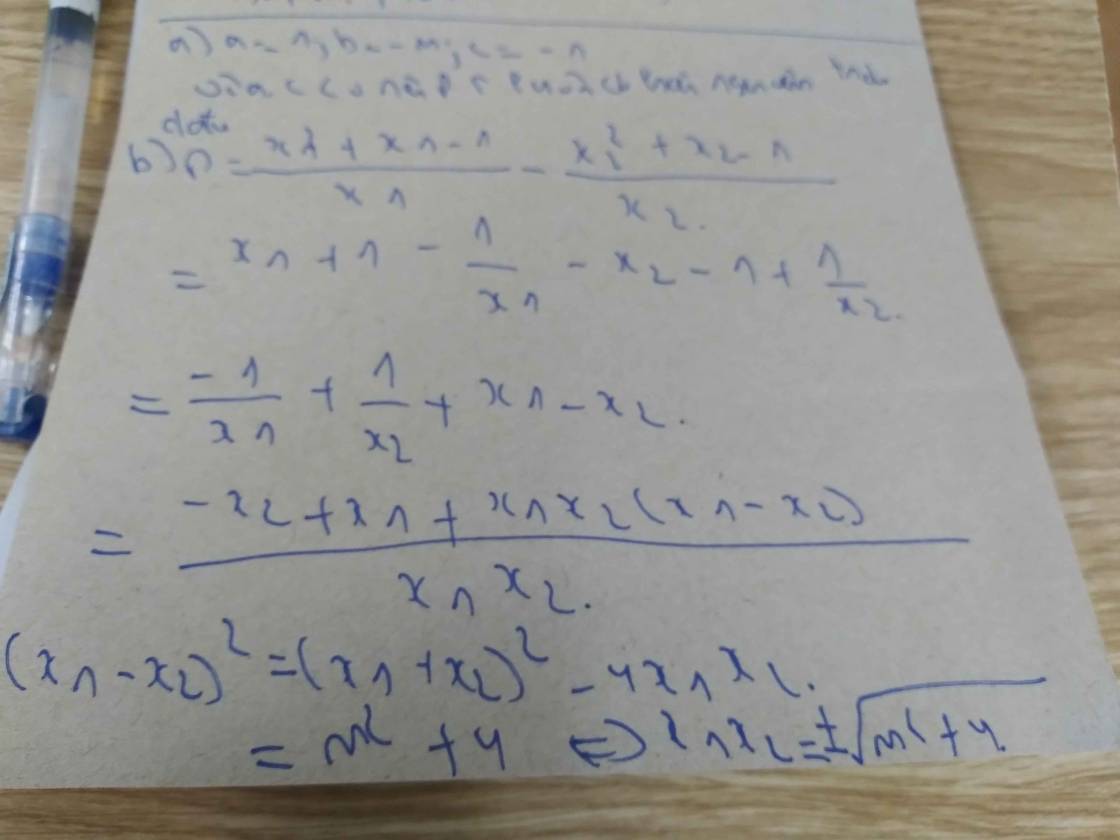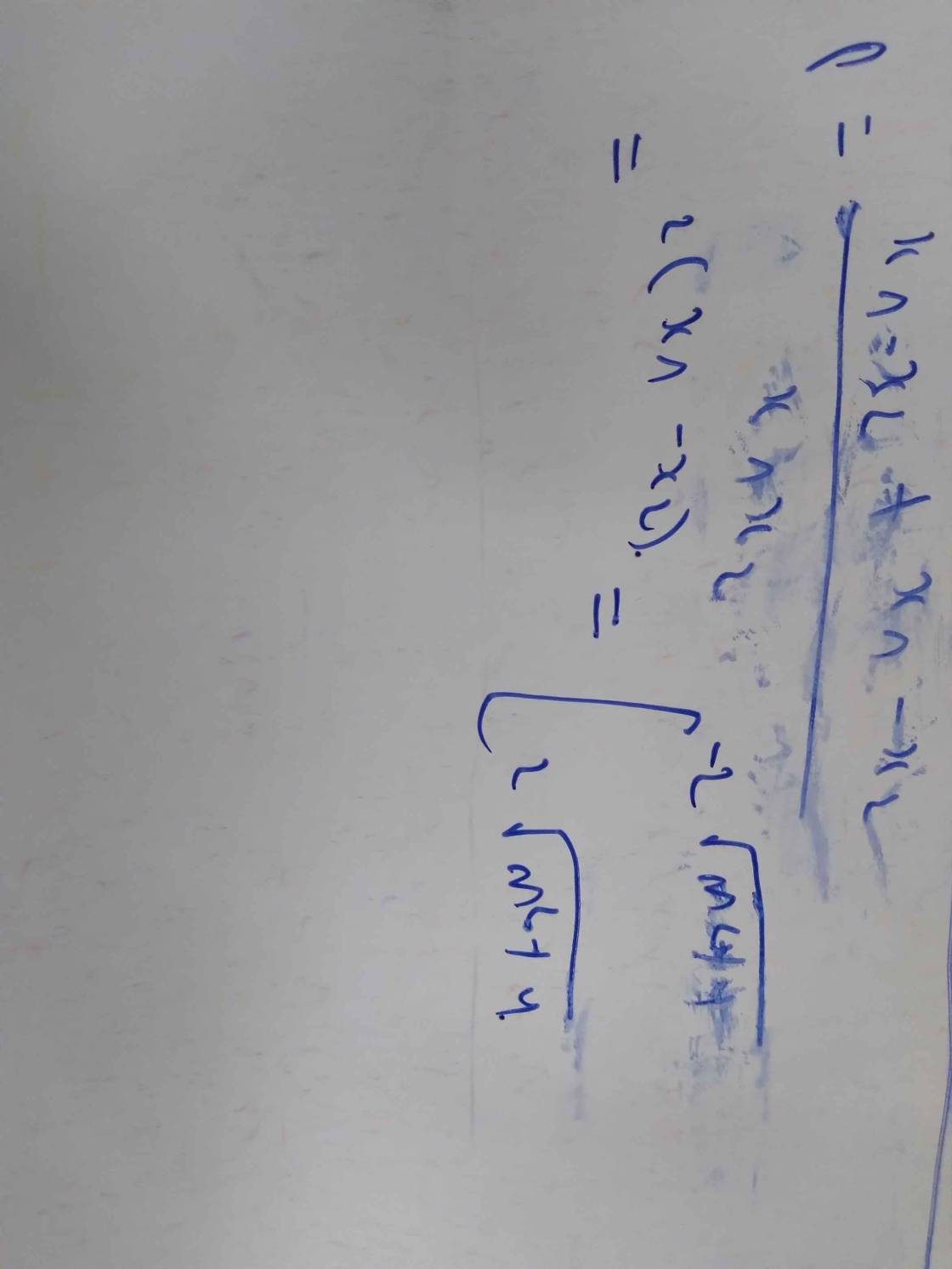Hãy nhập câu hỏi của bạn vào đây, nếu là tài khoản VIP, bạn sẽ được ưu tiên trả lời.

1. Theo hệ thức Vi-ét, ta có: \(\left\{{}\begin{matrix}x_1+x_2=-\dfrac{4}{3}\\x_1.x_2=\dfrac{1}{3}\end{matrix}\right.\)
\(C=\dfrac{x_1}{x_2-1}+\dfrac{x_2}{x_1-1}=\dfrac{x_1\left(x_1-1\right)+x_2\left(x_2-1\right)}{\left(x_1-1\right)\left(x_2-1\right)}\)
\(=\dfrac{x_1^2-x_1+x_2^2-x_2}{x_1x_2-x_1-x_2+1}=\dfrac{\left(x_1+x_2\right)^2-2x_1x_2-\left(x_1+x_2\right)}{x_1x_2-\left(x_1+x_2\right)+1}\)
\(=\dfrac{\left(-\dfrac{4}{3}\right)^2-2.\dfrac{1}{3}-\left(-\dfrac{4}{3}\right)}{\dfrac{1}{3}-\left(-\dfrac{4}{3}\right)+1}=\dfrac{\dfrac{22}{9}}{\dfrac{8}{3}}=\dfrac{11}{12}\)
\(1,3x^2+4x+1=0\)
Do pt có 2 nghiệm \(x_1,x_2\) nên theo đ/l Vi-ét ta có :
\(\left\{{}\begin{matrix}S=x_1+x_2=\dfrac{-b}{a}=-\dfrac{4}{3}\\P=x_1x_2=\dfrac{c}{a}=\dfrac{1}{3}\end{matrix}\right.\)
Ta có :
\(C=\dfrac{x_1}{x_2-1}+\dfrac{x_2}{x_1-1}\)
\(=\dfrac{x_1\left(x_1-1\right)+x_2\left(x_2-1\right)}{\left(x_2-1\right)\left(x_1-1\right)}\)
\(=\dfrac{x_1^2-x_1+x_2^2-x_2}{x_1x_2-x_2-x_1+1}\)
\(=\dfrac{\left(x_1^2+x_2^2\right)-\left(x_1+x_2\right)}{x_1x_2-\left(x_1+x_2\right)+1}\)
\(=\dfrac{S^2-2P-S}{P-S+1}\)
\(=\dfrac{\left(-\dfrac{4}{3}\right)^2-2.\dfrac{1}{3}-\left(-\dfrac{4}{3}\right)}{\dfrac{1}{3}-\left(-\dfrac{4}{3}\right)+1}\)
\(=\dfrac{11}{12}\)
Vậy \(C=\dfrac{11}{12}\)

Vì P = 6 / -2 = -3 < 0
=> Phương trình có hai nghiệm trái dấu
Áp dụng định lí Viet ta có:
\(\hept{\begin{cases}x_1x_2=\frac{6}{-2}\\x_1+x_2=\frac{3}{2}\end{cases}}\)
Ta có: \(\left|x_1-x_2\right|^2=\left(x_1+x_2\right)^2-4x_1x_2=\left(\frac{3}{2}\right)^2-4\left(\frac{6}{-2}\right)=\frac{57}{4}\)
=> \(\left|x_1-x_2\right|=\frac{\sqrt{57}}{2}\)

Theo Vi-ét, ta có:
\(\left\{{}\begin{matrix}x_1+x_2=-\dfrac{b}{a}=-\dfrac{3}{4}\\x_1x_2=\dfrac{c}{a}=-\dfrac{1}{4}\end{matrix}\right.\)
\(A=-2\left(x_1-2\right)\left(x_2-2\right)\)
\(=\left(-2x_1+4\right)\left(x_2-2\right)\)
\(=-2x_1x_2+4x_1+4x_2-8\)
\(=-2x_1x_2+4\left(x_1+x_2\right)-8\)
\(=-2.\left(-\dfrac{1}{4}\right)+4.\left(-\dfrac{3}{4}\right)-8\)
\(=\dfrac{1}{2}-3-8\)
\(=\dfrac{1}{2}-11\)
\(=-\dfrac{21}{2}\)

8.4/ Để phương trình có 2 nghiệm phân biệt thì \(\Delta'=\left(m+5\right)^2-\left(m^2+6\right)=10m+19>0\Leftrightarrow x>-\frac{19}{10}\)
Theo định lý viete, ta có: \(\left\{{}\begin{matrix}x_1+x_2=-2\left(m+5\right)\\x_1x_2=m^2+6>0\forall x\in R\end{matrix}\right.\)
Ta có: \(\left|x_1\right|+\left|x_2\right|=16\Leftrightarrow x_1^2+x^2_2+2\left|x_1x_2\right|=256\Leftrightarrow\left(x_1+x_2\right)=256\)
\(\Leftrightarrow-2\left(m+5\right)=256\Leftrightarrow m+5=-128\Leftrightarrow m=-133\) (không t/m)
Vậy khôn tồn tại m thõa mãn ycbt
8.3/ Để phương trình có 2 nghiệm phân biệt thì \(\Delta'=\left(m-4\right)^2-\left(m^2+7\right)=-8m+9>0\) \(\Leftrightarrow m< \frac{9}{8}\)
Theo định lý \(viete:\left\{{}\begin{matrix}x_1+x_2=2\left(m+4\right)\\x_1x_2=m^2+7>0\forall x\in R\end{matrix}\right.\)
Ta có: \(\left|x_1\right|+\left|x_2\right|=12\Leftrightarrow x_1^2+x^2_2+2\left|x_1x_2\right|=144\)
\(\Leftrightarrow\left(x_1+x_2\right)^2-2x_1x_2+2x_1x_2=\left(x_1+x_2\right)=144\)
\(\Leftrightarrow2\left(m+4\right)=144\Leftrightarrow m+4=72\Leftrightarrow m=68\) (T/m)
KL: ...........

Viết lại đề : \(x^2-2mx+m^2-1=0\left(a=1;b=-2m;c=m^2-1\right)\)( 1 )
a, Thay m = 1 vào pt (1) ta đc
\(x^2-2.1x+1^2-1=0\Leftrightarrow x^2-2x=0\)
\(\Leftrightarrow x\left(x-2\right)=0\Leftrightarrow\orbr{\begin{cases}x=0\\x=2\end{cases}}\)
b, Để phương trình có 2 nghiệm phân biệt thì \(\Delta>0\)
Tương ứng vs : \(\left(2m\right)^2-4\left(m^2-1\right)=4m^2-4m^2+4=4>0\)(EZ>33)
c, Áp dụng hệ thức Vi et ta có : \(x_1+x_2=2m;x_1x_2=m^2-1\)
Theo bài ra ta có : \(x_1+x_2=12\)Thay vào ta đc
\(\Leftrightarrow2m=12\Leftrightarrow m=6\)


a, \(3x^2+5x-6=0\) ( a=3 , b=5 , c=-6)
Ta xét ac=\(3\cdot\left(-6\right)=-18< 0\)
=>pt luôn có 2 nghiệm phân biệt
b , Vì phương trình trên có 2 nghiệm phân biệt
Ta áp dụng viet vào phương trình
\(\left\{{}\begin{matrix}x_1x_2=\frac{-6}{3}=-2\\x_1+x_2=-\frac{5}{3}\end{matrix}\right.\)
Ta có : \(\left(x_1-1\right)\left(x_2-1\right)+x_1^2+x_2^2\)
=\(x_1x_2-x_1-x_2+1+x_1^2+x_2^2\)
=\(\left(x_1^2+x_2^2+2x_1x_2\right)-x_1x_2-\left(x_1+x_2\right)\)
=\(\left(x_1+x_2\right)^2-\left(x_1+x_2\right)-x_1x_2\)
=\(\left(\frac{-5}{3}\right)^2-\left(-\frac{5}{3}\right)-\left(-2\right)\)
=\(\frac{25}{9}+\frac{5}{3}+2=\frac{58}{9}\)
bạn có chép đúng đề ko ạ, tại mình thấy căn đen ta lẻ quá